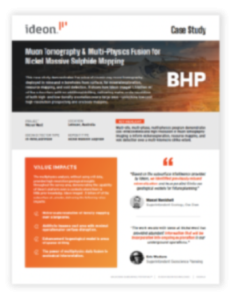Leinster
Multi-site, multi-phase, multi-physics program demonstrates cost-effectiveness and high resolution of muon tomography imaging to inform nickel exploration, resource mapping, and void detection of a multi-kilometre strike extent.
OVERVIEW
This case study demonstrates the value of cosmic-ray muon tomography, deployed in mine and in boreholes from surface, for mineral exploration, resource mapping, and void detection. It shows how Ideon imaged 1.5 billion3 of the subsurface with no additional drilling, delivering metre-scale resolution of both high- and low-density anomalies over a large area — unlocking low-cost, high-resolution prospecting and ore body mapping.
BACKGROUND
Cliff and Leinster mines are situated in the Agnew-Wiluna greenstone belt in Western Australia, approximately 150 km apart from each other, and a wholly owned by BHP and operated by BHP’s Nickel west group.
The Cliffs orebody consists of massive Fe-Ni sulphide mineralization associated with the basal contact of the Cliffs Ultramafic Unit (UCL). In its central and northern parts, the orebody presents as a N-trending, subvertical sheet, approximately 500m wide (down-dip) and plunging southward from surface for 1.5km. The UCL has a density of approximately 2.8g/cc, while the massive Fe-Ni sulphide ore domain has an average density of 3.9g/cc.
At Leinster, the Perseverance Ultramafic Complex (UPC) hosts several Type 1 Fe-Ni sulphide ore bodies. Immediately west of the UPC, the Rocky’s Reward Ultramafic (URR) is a structural slice of ultramafic rock that hosts the Rocky’s Reward and Harmony ore bodies. Mineralization is associated with distinct terrace structures hypothesized to recur down-dip of the known Rocky’s Reward terrace, which is the basis of the Balboa exploration target.
IDEON SOLUTION
Ideon deployed five in-mine detectors about 50m apart in an underground drive approximately 200m deep in the Cliffs mine, gathering data over a period of 60 days. With successful outcomes at Cliffs, those five detectors were relocated to a 2km-long drive in the Leinster mine at approximately 800m depth, screening the volume above for undiscovered massive Fe-Ni sulphide mineralization. These sensors were moved along the drive during the survey period to capture the full target zone above, for a total of approximately 8 months of active imaging.
The world’s first deployment of borehole muon tomography for nickel exploration then took place at the Balboa exploration site, with nine detectors positioned in three drill holes around a target zone for new mineralization. Imaging took place over a period of approximately 4.5 months.
Ideon used provided airborne gravity gradient and ground gravity data to perform a multi-physics joint inversion and deliver a robust, unified 3D model of the Leinster area. BHP leveraged extensive drill data to validate the outcomes in areas where drill information was available.


Placement of five in-mine detectors in the Cliffs mine.


